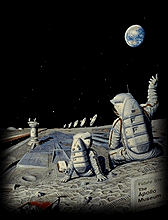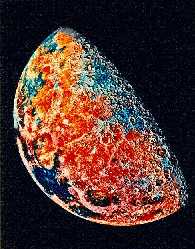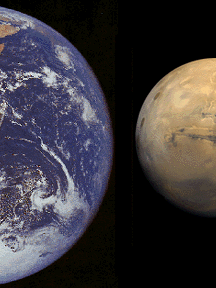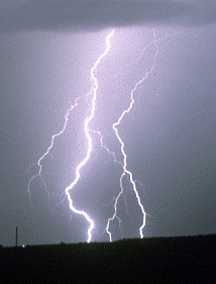This is an image of the Moon showing various minerals found on the surface.
Click on image for full size
NASA
About Lunar Water
In the past everyone thought that the Moon had no water. Moon rocks found by Apollo astronauts contained no traces of water. Lunar mapping performed by the Galileo spacecraft, shown here, found no traces of water. The recent
Clementine mission, an Airforce mission, made measurements however, which suggested that small, frozen
pockets of ice may be found in
shadowed regions of the lunar crust. Although the
pockets are thought to be small, the overall amount
of water may be large, perhaps the size of Lake
Erie.
This water may come from comets which hit the Moon from time to time. Water may also come from individual water molecules which migrate to the coldest regions of the Moon where they refreeze on the surface, trapped inside enormous craters at the lunar poles. Some of these deep craters never receive any light from the Sun, they are permanently in the shade.
It is in such craters that instruments on board the Lunar Prospector spacecraft found frozen water. This water-ice could make space operations on the Moon possible, since carrying water from Earth is very expensive.
You might also be interested in:

How did life evolve on Earth? The answer to this question can help us understand our past and prepare for our future. Although evolution provides credible and reliable answers, polls show that many people turn away from science, seeking other explanations with which they are more comfortable.
...more
The tiny Lunar Prospector probe launched in January 1998 has found the answer to the most controversial question in lunar science. The Lunar Prospector has found that there is indeed water-ice located
...more
Any successful theory must account for everything we know about the Moon now. Those things include the moon seems to be made of the same material as the Earth's upper mantle. the Moon has little or no
...more
Although the Moon does not appear to have a magnetosphere surrounding it, it *is* a magnetic object in space. Scientists think that the magnetism of the Moon's surface is leftover from a time when the
...more
The atmosphere of the Moon may come from a couple of sources, one source is outgassing which means gases coming from deep within the Moon. Gases are released from the interior of the Moon during moonquakes.
...more
In the past everyone thought that the Moon had no water. Moon rocks found by Apollo astronauts contained no traces of water. Lunar mapping performed by the Galileo spacecraft, shown here, found no traces
...more
Any successful theory must account for everything we know about the Moon now, as well as make predictions about future observations. There are three theories about how the moon came to be in place: that
...more
Here's a safe and easy way to make lightning. You will need a cotton or wool blanket. This experiment works best on a dry, cool night. Turn out all the lights and let your eyes adjust to the darkness.
...more











